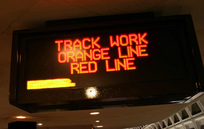More weekend closures, less single-tracking for Metrorail

Photo by ElvertBarnes on Flickr.
To save time and money, Metro is revising the way they do some track work. Instead of single-tracking through work zones, Metro will now close whole line segments more often.
When BART was being designed, a 1971 article in the IEEE Transactions on Industry and General Applications described its system for avoiding shutdowns by single-tracking:
The BART system will provide service at 90-s intervals during peak demand periods, extending to as long as 15-min intervals during the low-demand early morning hours. At no time will service be discontinued; by the use of carefully placed crossovers and the control of trains in a reverse running mode, maintenance work on the roadbed can be performed without serious disruption of the service.
But in 1971 BART had yet to open, and the Metrorail system had only broken ground two years earlier. Operating experience in the years since has shown that while single-tracking may preserve service, it does so at the expense of lengthened headways and disruptions along the entire length of the line.
Today, taking this experience into account, WMATA has announced a new approach to weekend track work on the Metrorail system, in which entire sections of lines will be closed and replaced with buses.
Single-tracking doesn’t just disrupt riders in the work area itself; it slows down the entire line, and affects riders throughout the Metrorail system.
WMATA’s new approach to track work will preserve service on the open portions of lines, and avoid the follow-on effects which usually occur when trains are single-tracking.
Closing lines to speed repairs is, by itself, nothing new. In 2006, London Underground elected to close the Waterloo & City Line in its entirety for five months, in order to avoid a projected 70 weekend closures necessary to complete the major overhaul of the line.
Because of the complete closure, weekday riders who would have been spared disruption under a program of weekend closures instead had to take alternate routes. But because the complete closure was more efficient, the work was done (and the disruption ended) in 5 months, rather than in more than a year for weekend closures alone.
New York City’s MTA has also been examining partial line closures as an alternative to frequent evening and weekend disruption. No decision has been made yet, but MTA Chairman Jay Walder seems to think it’s a strategy that’s proven itself in London, and which may prove viable in New York as well.
So, how well will this strategy work for Metrorail? At the extremities of lines, complete closures will probably be superior to single-tracking. Work will go faster with no trains running through the work areas, and the unaffected parts of the line won’t have to contend with the bottleneck caused by single-tracking. In the core of the network, though, where ridership levels are high even on weekends, shuttle buses may end up swamped with passengers, leading to delays for riders traveling through the closed areas.
In the end, riders will face disruption whether trains are single-tracking or replaced with shuttle buses—but in this case, replacing trains with shuttle buses means a faster end to the work, and a quicker return to normalcy.
